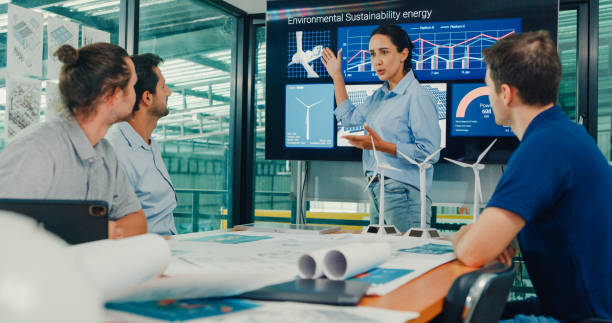The Roadmap in Action: Leadership Lessons in Sustainable Energy

Effective sustainability leadership requires more than vision, it demands action, adaptability, and deep collaboration. In this article, Lauretta Pearse, Distribution Improvements Engineer at ATCO Energy Systems, draws on three real-world case studies to illustrate how leaders are driving meaningful progress in energy efficiency, infrastructure resilience, and decarbonization across Canada. From federal parks to municipal landfills and major transit projects, these examples reveal how innovative thinking and coordinated efforts can turn sustainability goals into measurable outcomes.
The Essence of Sustainability Leadership
Successful leadership in energy transition and sustainability involves embracing challenges, fostering collaboration, resourcefulness, and stepping out of comfort zones. Leaders achieve significant milestones by embodying these traits in their everyday actions. Tackling complex projects means confronting uncertainty, and influential leaders rise to these occasions, meeting each challenge with resilience and determination. A readiness to venture into unfamiliar territory—whether adopting new strategies, facing regulatory hurdles, or addressing technical complexities—highlights an openness to innovate and move beyond the status quo.

Resourcefulness and Collaboration
Resourcefulness is another essential trait, enabling effective solutions even when faced with limitations. Leaders who can make the most of available resources, solve problems creatively, and ensure project success regardless of constraints demonstrate adaptability and strategic thinking.
Collaboration is not just a key aspect, but the very backbone of impactful energy and sustainability initiatives. Leaders who foster strong relationships across diverse teams and stakeholders create an environment of open communication and alignment. This shared focus not only helps drive projects to successful outcomes but also makes every individual involved feel valued and integral to the process.
“Collaboration is not just a key aspect, but the very backbone of impactful energy and sustainability initiatives”
-Lauretta Pearse
Case Studies in Leadership and Impact
This article explores how dedicated expertise, coupled with effective leadership, can significantly impact energy efficiency, infrastructure sustainability, and decarbonization initiatives using three case studies.
Energy Management and Decarbonization: A Case Study in Canada’s National Parks

The Challenge and Objectives
The energy management project’s primary goal was to help a federal client mitigate climate change by transitioning to clean energy, implementing energy-efficient solutions, and ensuring climate resilience across its diverse portfolio of buildings and assets within 27 National Parks. Specifically, the client was focused on reducing greenhouse gas (GHG) emissions and improving energy efficiency while exploring options for decentralized power generation and intelligent building technologies.
The objectives of this initiative included:
- Energy Efficiency: Assess opportunities to reduce energy consumption and GHG emissions in the client’s buildings and utility assets.
- Climate Resilience: Develop strategies to help protect at-risk assets from climate-related events by identifying climate adaptation measures.
Strategies and Outcomes
Energy Conservation and Carbon Emissions Reduction efforts focused on assessing 200 pre-selected buildings to identify opportunities for decreasing energy consumption and carbon emissions. The focus was on practical energy conservation measures (ECMs), particularly those that could be implemented in ongoing maintenance. These included integrating photoluminescent systems, switching to LED lighting, and other straightforward optimizations.
The results were substantial: A projected 12% reduction in grid electricity consumption and a 17% reduction in carbon emissions, equivalent to 681 tCO2eq/year, was expected. These savings were largely achievable through maintenance-based activities and prioritizing energy-saving ECMs. Additionally, 446 adaptation measures were identified for assets at high risk from climate hazards, helping ensure resilience in the face of climate change.
“The results were substantial: A projected 12% reduction in grid electricity consumption and a 17% reduction in carbon emissions, equivalent to 681 tCO2eq/year, was expected.”
-Lauretta Pearse
Key Lessons and Methodologies
- Stakeholder Coordination: Weekly meetings were instrumental in maintaining focus and breaking down silos between disciplines.
- Data Innovation: Benchmarking and engineering judgment were used to compensate for limited data.
- Comprehensive Data Utilization: A centralized database allowed for integrated asset understanding and replicable project tracking.
Sustainability Metrics and Lifecycle Planning: A Case Study in Municipal Infrastructure
The Challenge and Objectives
This project aimed to integrate sustainability metrics into the decision-making process for rehabilitating a municipal landfill cap. Adopting a multi-criteria analysis (MCA) approach focused on reducing the environmental footprint while enhancing overall infrastructure sustainability.
Strategies and Outcomes
The team developed an innovative method to evaluate landfill cap rehabilitation options by modelling lifecycle emissions, which included assessing the embodied carbon of each option and estimating fugitive methane emissions based on anticipated landfill gas production and destruction efficiency.

Eventually, the recommended rehabilitation approach translated into a reduction of 37 tCO2eq in embodied carbon and a 17% reduction in annual greenhouse gas emissions compared to the conventional choice.
Key Lessons and Methodologies
- Data Collection: Addressed through collaboration, site visits, and resolving data inconsistencies.
- Regulatory Compliance: Met stringent standards through deep regulatory expertise.
Energy Utility Leadership: A Case Study in Advancing Calgary’s Greenline LRT Project
The Challenge and Objectives
The $4.9 billion Greenline Light Rail Transit (LRT) project in Calgary represented an enormous opportunity for sustainable urban development, but it required navigating a range of technical and regulatory obstacles.

Strategies and Outcomes
A critical effort involved managing alignment conflicts between natural gas lines and LRT tracks, with a team dedicated to realigning gas lines to prevent construction delays. Weekly stakeholder meetings involving over 30 participants required thorough preparation and a strong focus on consensus-building.
The anticipated outcomes include a reduction of 30,000 tonnes of greenhouse gas emissions annually due to decreased vehicle use and an estimated $2.2 billion in economic benefits, such as job creation and improved urban mobility.
Key Lessons and Methodologies
- Technical Complexity: Required creative realignment planning to avoid service disruptions.
- Regulatory Navigation: Ensured safety and compliance through close coordination with authorities.
Final Takeaways: Principles for Sustainable Leadership
In conclusion, some key takeaways from these case studies include the importance of:
- Start with achievable goals—small wins, such as energy conservation measures through maintenance activities, can build momentum for larger projects.
- Effective stakeholder engagement—Clear communication and consensus-building are essential for aligning goals and overcoming internal obstacles.
- Innovative problem-solving—When faced with data gaps or technical challenges, Creativity and persistence can lead to practical solutions.
- Thought leadership—Beyond project work, the author has contributed significantly to thought leadership and research in the energy sector. Sharing knowledge through writing, research, and public speaking can inspire others and help shape the future of the energy sector.
By following these principles, sustainability professionals can not only achieve measurable environmental benefits but also contribute to the broader goal of decarbonizing our world and building a sustainable future.














